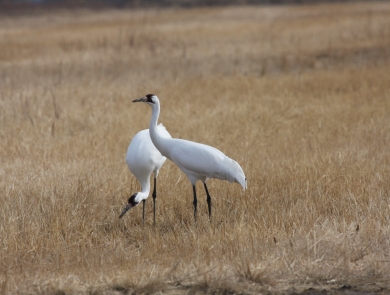What We Do
Our Services
Among our major roles in bird management and habitat conservation, we conduct surveys; coordinate with public-private bird conservation partnerships; provide matching grants for partner-based conservation efforts; administer conservation laws and develop policies and regulations; and issue permits that allow individuals and organizations to participate in migratory bird conservation in a variety of ways.
We also help educate and engage our nation's youth in wildlife conservation topics and provide resources for parents and educators who want to help their students explore and appreciate our natural world and our feathered friends.
Our Projects and Initiatives
The USFWS has been a leader in migratory bird conservation since the founding of the Service. Our efforts focus migratory bird conservation at large flyway and continental scales. We identify and coordinate with our State, Federal and nonprofit partners to respond to emerging conservation and hunting issues. We work with our partners to build public understanding of migratory bird conservation. We also lead the federal family in bird conservation issues.
One of our core responsibilities is managing game species to provide for recreational and subsistence hunting opportunities and authorizing take of migratory birds in a manner that is compatible with the four international treaties. We must strive for continual improvements and efficiency in issuing permits while maintaining sustainable populations of birds.
Because the quantity, quality, availability, and distribution of habitats are important drivers of bird populations, the loss and degradation of natural habitats are key factors in the declines of many migratory bird species. Ensuring the future of migratory birds requires the effective conservation of breeding, wintering, and migration habitats throughout their annual cycle to sustain populations at desired levels. Strategic, adaptive, collaborative approaches that address habitat requirements of birds at landscape scales are paramount, so that finite resources can be leveraged across organizational lines and targeted toward “local” habitat conservation actions expected to best support range-wide objectives for population sustainability.
The Migratory Bird Program manages data as a strategic asset and a “trust resource” by developing information systems that improve customer service, government transparency, decision-making, and accessibility for the public.
Our Laws and Regulations
A fairly large number of international treaties and domestic laws have been enacted that provide protection for migratory birds. To help put the legal authorities into perspective, we have categorized them as primary and secondary authorities. Primary authorities are international conventions and major domestic laws that focus primarily on migratory birds and their habitats. Secondary authorities are broad-based domestic environmental laws that provide ancillary but significant benefits to migratory birds and their habitats.
Our Services
Whether you contribute as a partner in a grant project, engage with local organizations through the Urban Bird Treaty program, co-host a special event with partners in your area, or buy a Federal Migratory Bird Hunting and Conservation (Duck) Stamp - supporting one of the nation's oldest and most successful conservation programs - YOU have an opportunity to play a crucial role in bird conservation.
Our Library
Data obtained from various migratory bird surveys and programs are used to produce reports and publications, guidance documents, management and conservation plans, and hunting regulations - all of which are necessary to conserve and manage migratory birds.
Projects and Research
The Migratory Bird Program develops and implements a variety of activities designed to inform bird conservation policies and initiatives. These activities are numerous and varied, and are undertaken by a wide variety of organizations through partnerships as well as by the public through various citizen action and citizen science initiatives.
Interested in how you can report a banded bird or how the U.S. Fish and Wildlife Service Migratory Bird Program uses this information? Maybe you'd like to know more about reward bands or what types of birds are banded? Read on to find the answers!
Reporting Banded BirdsIf you have found or harvested a banded bird, please report it at www.reportband.gov. You'll need the...
The annual process of setting duck hunting regulations in the United States is based on a system of resource monitoring, data analyses, and rule making.
Each year, monitoring activities such as aerial surveys and hunter questionnaires provide information on harvest levels, population size, and habitat conditions. Data collected from this monitoring program are analyzed...
Our Species
The Migratory Bird Program utilizes a number of different lists to direct U.S. Fish and Wildlife Service actions and priorities to manage and protect migratory birds.



















